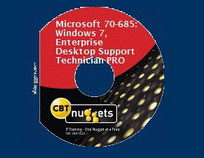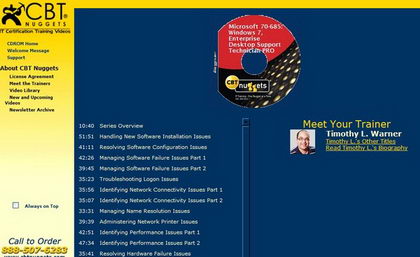XYZ軟體急先鋒


CBT Nuggets Microsoft 70-685 Windows 7 Enterprise Desktop Support Technician Windows 7企業版桌面支援技術員培訓視頻教學 英文正式版(DVD一片裝)
-=-=-=-=-=-=-=-=-=-=-=-=-=-=-=-=-=-=-=-=-=-=-=-=-=-=-=-=-=-=-=-=-=-=-=-=
軟體名稱:CBT Nuggets Microsoft 70-685 Windows 7 Enterprise Desktop Support Technician Windows 7企業版桌面支援技術員培訓視頻教學 英文正式版(DVD一片裝)
語系版本:英文DVD版
光碟片數:單片裝
破解說明:
系統支援:For WIN 95/WIN 98/WIN ME/WIN-NT/WIN 2000
軟體類型:Windows 7企業版桌面支援技術員培訓視頻教學
硬體需求:PC
更新日期:2011-01-15
官方網站:http://www.cbtnuggets.com/series?id=607
中文網站:
軟體簡介:
銷售價格:$180元
-=-=-=-=-=-=-=-=-=-=-=-=-=-=-=-=-=-=-=-=-=-=-=-=-=-=-=-=-=-=-=-=-=-=-=-=
軟體簡介:
CBT NUGGETS出品的考試教學課程:Exam-Pack 70-685 Microsoft PRO: Windows 7,
企業桌面支持技術員 (Exam-Pack 70-685 Microsoft PRO: Windows 7, Enterprise
Desktop Support Technician)
主講:Timothy L. Warner | 時長:12 小時
課程將學習解決棘手的Windows 7桌面支持方面的難題,通過訓練講授深入的支持技術
,達到伺服器端配置水準要求。
另外,課程還將接觸到許多補充資訊,涉及到動手應用強大的解決問題的資源。
課程適用於Microsoft exam 70-685考試。幫助準備微軟認證桌面支持技術員 MCITP認
證考試。
Learn to solve stubborn Windows 7 desktop support problems with training
that teaches you in-depth support skills -- right down to the server-side
configuration level.
Plus, you''ll find yourself connected to loads of supplemental information
and links that put powerful problem-solving resources at your fingertips.
This training maps to Microsoft exam 70-685. In no time, you''ll be ready
for the test and one step closer to MCITP certification as a Desktop Support
Technician.
目錄:
What You'll Learn
Series 1:
*
Video 1: Series Overview|10:40
About this Series. About Microsoft DST Certification. About the 70-685 Exam.
In this nugget we introduce the series and describe how it (a) matches the
Microsoft-published exam objectives extremely closely; and ( will help you
attain your certification goal in minimal time. We also describe the somewhat
confusing world of Microsoft Desktop Support Technician (DST) certification,
paying particular attention to the 70-685 test.
*
Video 2: Handling New Software Installation Issues|51:51
Controlling Installation Permissions. Deploying AppLocker. Managing Driver
Signing. Understanding Licensing Options. We dive right into the material in
this nugget. Here we learn how software installation works out of the box in
Windows 7. We also learn how to use AppLocker, the new and powerful method for
controlling software installation on Windows 7 systems. We also cover device
driver signing, digital certificates, and how Microsoft licensing works with
respect to Windows 7. Relevant Exam Objectives: Identify and resolve new software
installation issues.
*
Video 3: Resolving Software Configuration Issues|41:11
Enabling and Disabling Features. Deploying Application Shims. Pointing to a
Network Resource. In this nugget we learn how to manage installed software in
Windows 7. We cover how to enable and disable out-of-box features, how to use
the Application Compatibility Toolkit (ACT) to deploy application shims, and
then how to make client-side network connections to server-based resources.
Relevant Exam Objectives: Identify and resolve software configuration issues.
*
Video 4: Managing Software Failure Issues Part 1|42:26
Checking Event Logs. Accessing Safe Mode. Repairing a Windows 7 Installation.
In this nugget we explore the myriad ways to troubleshoot a failed software
installation in Windows 7. Specifically, we perform a deep-dive into the Windows
Event Logs, Safe mode and other diagnostic boot modes, and then finish with a
consideration of the Windows 7 repair process. Relevant Exam Objectives: Identify
cause of and resolve software failure issues.
*
Video 5: Managing Software Failure Issues Part 2|39:45
Managing Programs and Features. Restoring or Reimaging Windows 7. Editing the
Default Settings on the System Image. In this nugget we go further in learning to
master software management and uninstallation in Windows 7. We also cover
administration of Windows 7 operating system images, including how to customize
a reference OS image using the Microsoft deployment tools in Windows Server 2008
R2. Relevant Exam Objectives: Identify cause of and resolve software failure issues.
*
Video 6: Troubleshooting Logon Issues|35:23
Logon Context. Trust Relationships with Computer Accounts. Password expiration
and Logon Hours Compliance. In this nugget we tackle the extremely common DST
troubleshooting issue of the failed network logon. We discuss the trusted connection
that exists between a client and a server computer in an Active Directory Domain
Services (AD DS) environment. We also look at password expiration and logon hours
compliance and how these play into resolving users’ logon problems. Relevant Exam
Objectives: Identify and resolve logon issues.
*
Video 7: Identifying Network Connectivity Issues Part 1|35:56
Determining the Issue Scope. TCP/IP Configuration. Testing Network Connectivity.
In this nugget we begin with an overview of network troubleshooting methodology,
paying particular attention to determining issue scope. Next we ensure that we
have the basics of client-side TCP/IP configuration down. We finish with using
various built-in Windows 7 command-line tools in order to test and troubleshoot
network connectivity. Relevant Exam Objectives: Identify and resolve network
connectivity issues.
*
Video 8: Identifying Network Connectivity Issues Part 2|35:07
BranchCache Overview. The Default Gateway. Network Location Awareness. We begin
this nugget by providing a detailed discussion of BranchCache, a cool new Windows
Server 2008 R2 feature that provides Windows 7 clients and their users much faster
access to shared resources in a multi-side Active Directory internetwork. We then
examine the role of the default gateway in routed TCP/IP communications, and spend
the remainder of our time togeter in this nugget mastering the mechanics of the
Network Location Awareness (NLA) service and how this technology interplays with
Windows Firewall, Group Policy, and AD DS. Relevant Exam Objectives: Identify and
resolve network connectivity issues.
*
Video 9: Managing Name Resolution Issues|33:31
Verifying Name Resolution Configuration. Managing the DNS Cache. Using nslookup.
In this nugget we perform a deep-dive into Domain Name System (DNS) and how we can
leverage our expertise with server-side setup to resolve client-side name resolution
problems. Specifically, we learn how to manage the client-side name resolve cache
and use nslookup to query resource records on an authoritative DNS server. Relevant
Exam Objectives: Identify and resolve names resolution issues.
*
Video 10: Administering Network Printer Issues|39:39
Hardware and Printer Failure. Server-Side Configuration. Managing Driver Issues.
Handling Network Issues. Because printing is both a core network service as well
as a popular vector for DST troubleshooting, we spend a significant amount of time
here learning practical strategies for approaching hardware failure, software
failure, server-side print queue configuration, and how to administer network drivers
and associated services. Included in this nugget is a practical overview of the
nifty Print Management Microsoft Management Console (MMC) tool. Relevant Exam
Objectives: Identify and resolve network printer issues.
*
Video 11: Identifying Performance Issues Part 1|42:51
Analyzing System and Application Logs. Troubleshooting Services. Using Performance
Monitor. In this nugget we learn to “put our finger on the pulse,” as it were, of a
troublesome, or suspected troublesome, Windows 7 system. Specifically, we learn how
to analyze the appropriate Windows event logs, troubleshoot system services, and use
the Performance Monitor console. Relevant Exam Objectives: Identify and resolve
performance issues.
*
Video 12: Identifying Performance Issues Part 2|47:34
Configuring Power Management. Managing Hard Drive Space. Optimizing Virtual Memory.
In this nugget we carry over our discussion started in the previous nugget on performance
monitoring and tuning in Windows 7. Here we begin with power management, and then move
on to managing hard drive space and optimizing virtual memory. Relevant Exam Objectives:
Identify and resolve performance issues.
*
Video 13: Resolving Hardware Failure Issues|35:41
Hardware Troubleshooting Tools. Resolving Hard Drive Issues. Updating the System BIOS.
Diagnosing Memory Failure Issues. In this nugget we shift our attention away from
software and turn to how to resolve hardware-related issues in Windows 7 systems. To
wit, we start with an overview of built-in hardware troubleshooting tools. Next we
examine hard drive issues, learn the whys and hows of updating the system BIOS, and
finish by learning how to use the slick Windows 7 Memory Diagnostic tool. Relevant
Exam Objectives: Identify and resolve hardware failure issues.
*
Video 14: Managing Wireless Connectivity Issues|31:24
Client-Side Wireless Configuration. Managing Data Encryption. Using Wireless
Profiles. Group Policy Management. More than ever before in business, IEEE 802.11
wireless connectivity is a core network service offered to users and site visitors.
Therefore, as DSTs we need to learn the proverbial ins and outs of client-side
wireless connection management, understand wireless data encryption protocols, as
well as how to set up and manage wireless profiles both manually and with the help
of Windows Server 2008 R2 domain Group Policy. Relevant Exam Objectives: Identify
and resolve wireless connectivity issues.
*
Video 15: Handling Remote Access Issues|43:55
Remote Access Connection Methods. Managing Access and Authentication.
Troubleshooting Client Connectivity. Description: Assisting remote users in
establishing virtual private network (VPN) connections is part of most DSTs’
job roles. In this nugget we review the remote access connection methods that
are supported by Windows 7 and Windows Server 2008 R2 Network Policy Server.
We delve into the arcana of remote access/VPN protocols to ensure secure
authentication and data confidentiality. Finally, we learn how to troubleshoot
client remote access connections. This nugget also provides an overview of the
Connection Manager Administration Kit (CMAK), a tool for simplifying the deployment
of remote access profiles to several Windows 7 client computers. Relevant Exam
Objectives: Identify and resolve remote access issues.
*
Video 16: Solving Internet Explorer Security Issues|44:44
Adding Trusted Sites. Accessing Advanced Options. Managing Add-ins. Administering
Digital Certificates. Group Policy Restrictions. Any revision to the Microsoft
Internet Explorer Web browser is bound to introduce both a new learning curve as
well as new opportunities for troubleshooting. In this nugget we review how IE
security zones work. We also rummage around in the Internet Explorer “advanced
options” feature set, including how to manage add-ins, digital certificates, and
Group Policy software restrictions. Relevant Exam Objectives: Identify and resolve
Windows Internet Explorer security issues.
*
Video 17: Resolving Issues Due to Malicious Software|37:58
Resolving Malware Infections. Malware Protection Tools. In this nugget we cover
practical approaches to resolving malicious software infections on Windows 7
systems, with an eye toward preventing their reoccurrence. We also review all
of the anti-malware tools Microsoft both bundles with Windows 7 and/or offers to
the public as separate products. Relevant Exam Objectives: Identify and resolve
issues due to malicious software.
*
Video 18: Identifying Encryption Issues|40:37
Understanding EFS. Understanding BitLocker. Introducing BitLocker to Go. In
this nugget we clearly delineate the two primary methods of deploying file system
data encryption in Windows 7: Encrypting File System (EFS) and BitLocker. We also
spend some time looking at a new addition to the BitLocker technology: BitLocker
To Go, which offers full volume protection for removable media, such as USB flash
drives. Relevant Exam Objectives: Identify and resolve encryption issues.
*
Video 19: Administering Software Update Issues|30:27
Verifying Software Update Status. Configuring Automatic Update. Troubleshooting
Update incompatibilities. The unfortunate bottom line with Microsoft software
updates is, as most working DSTs know, that sometimes updates “break” the systems
on which the updates are installed. In this nugget we take a proactive approach
to patch management in a Windows 7/Windows Server 2008 R2 environment. Specifically,
we learn how to verify software update status in Windows 7, configure Automatic
Update, and troubleshoot update compatibilities. In this nugget we also review
Windows Server Update Service (WSUS) to ensure that we have a well-rounded
understanding of Windows Update technologies. Relevant Exam Objectives: Identify
and resolve software update issues.
-=-=-=-=-=-=-=-=-=-=-=-=-=-=-=-=-=-=-=-=-=-=-=-=-=-=-=-=-=-=-=-=-=-=-=-=

